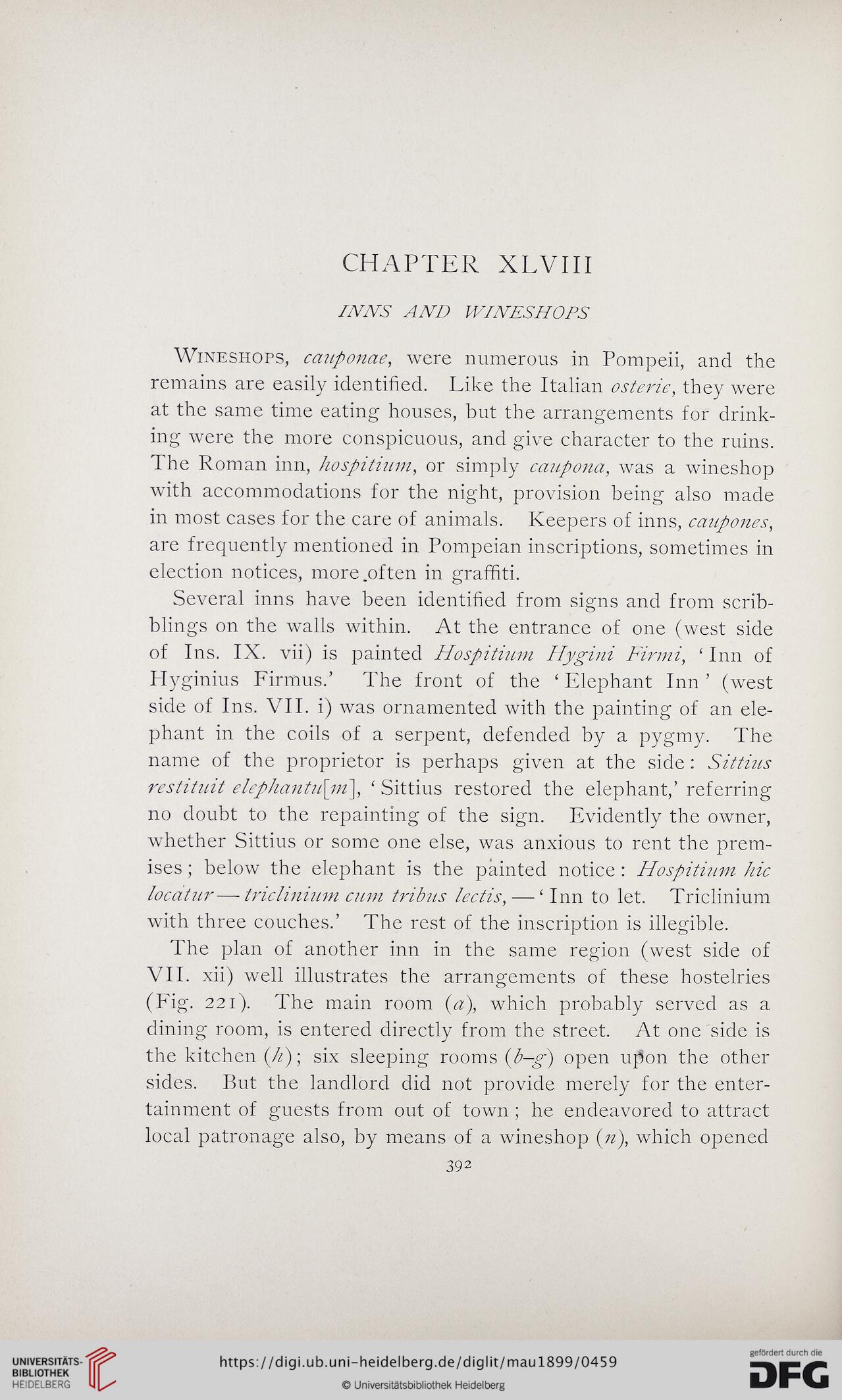CHAPTER XLVIII
INNS AND WINESHOPS
Wineshops, cauponae, were numerous in Pompeii, and the
remains are easily identified. Like the Italian osterie, they were
at the same time eating houses, but the arrangements for drink-
ing were the more conspicuous, and give character to the ruins.
The Roman inn, hospitium, or simply caupona, was a wineshop
with accommodations for the night, provision being also made
in most cases for the care of animals. Keepers of inns, caupones,
are frequently mentioned in Pompeian inscriptions, sometimes in
election notices, more .often in graffiti.
Several inns have been identified from signs and from scrib-
blings on the walls within. At the entrance of one (west side
of Ins. IX. vii) is painted Hospitium Hygini Firmi, 1 Inn of
Hyginius Firmus.’ The front of the ‘ Elephant Inn ’ (west
side of Ins. VII. i) was ornamented with the painting of an ele-
phant in the coils of a serpent, defended by a pygmy. The
name of the proprietor is perhaps given at the side : Sittius
restituit elcphantu\m\, ‘ Sittius restored the elephant,’ referring
no doubt to the repainting of the sign. Evidently the owner,
whether Sittius or some one else, was anxious to rent the prem-
ises ; below the elephant is the painted notice : Hospitium hie
loedtur-—-triclinium cum tribus lectis,— ‘Inn to let. Triclinium
with three couches.’ The rest of the inscription is illegible.
The plan of another inn in the same region (west side of
VII. xii) well illustrates the arrangements of these hostelries
(Fig. 221). The main room (zz), which probably served as a
dining room, is entered directly from the street. At one side is
the kitchen (/z); six sleeping rooms (b-g) open upon the other
sides. But the landlord did not provide merely for the enter-
tainment of guests from out of town ; he endeavored to attract
local patronage also, by means of a wineshop (zz), which opened
392
INNS AND WINESHOPS
Wineshops, cauponae, were numerous in Pompeii, and the
remains are easily identified. Like the Italian osterie, they were
at the same time eating houses, but the arrangements for drink-
ing were the more conspicuous, and give character to the ruins.
The Roman inn, hospitium, or simply caupona, was a wineshop
with accommodations for the night, provision being also made
in most cases for the care of animals. Keepers of inns, caupones,
are frequently mentioned in Pompeian inscriptions, sometimes in
election notices, more .often in graffiti.
Several inns have been identified from signs and from scrib-
blings on the walls within. At the entrance of one (west side
of Ins. IX. vii) is painted Hospitium Hygini Firmi, 1 Inn of
Hyginius Firmus.’ The front of the ‘ Elephant Inn ’ (west
side of Ins. VII. i) was ornamented with the painting of an ele-
phant in the coils of a serpent, defended by a pygmy. The
name of the proprietor is perhaps given at the side : Sittius
restituit elcphantu\m\, ‘ Sittius restored the elephant,’ referring
no doubt to the repainting of the sign. Evidently the owner,
whether Sittius or some one else, was anxious to rent the prem-
ises ; below the elephant is the painted notice : Hospitium hie
loedtur-—-triclinium cum tribus lectis,— ‘Inn to let. Triclinium
with three couches.’ The rest of the inscription is illegible.
The plan of another inn in the same region (west side of
VII. xii) well illustrates the arrangements of these hostelries
(Fig. 221). The main room (zz), which probably served as a
dining room, is entered directly from the street. At one side is
the kitchen (/z); six sleeping rooms (b-g) open upon the other
sides. But the landlord did not provide merely for the enter-
tainment of guests from out of town ; he endeavored to attract
local patronage also, by means of a wineshop (zz), which opened
392




